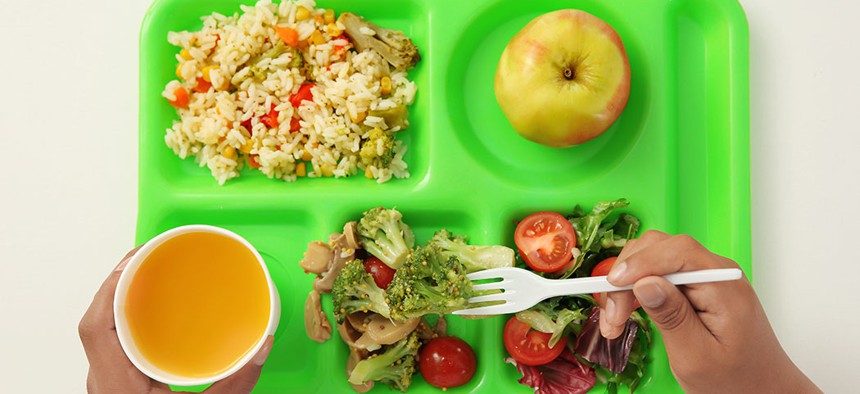The New York City Department of Education has been making headlines recently for high-profile changes to school menus, including Meatless Mondays – deployed citywide in March – and a ban on chocolate milk reported earlier this month. Both were touted by the de Blasio administration as steps to make school food healthier, but were met with derision from conservative pundits who see Meatless Mondays as performative, and resistance from farmers who fear a chocolate milk ban could hurt the dairy industry.
While these measures have been the most controversial, it’s part of a quieter effort to improve school meal nutrition more broadly.
On the surface, cutting meat from the menu on Mondays appears to have minimal health benefits – chicken and beef options have largely been replaced by high-fat dishes such as macaroni and cheese and mozzarella sticks. But New York City-based nutritionist Amy Shapiro said that both can be part of a healthy, balanced diet, which she said schools have been making strides to provide. “I do think these shifts are positive,” Shapiro said, while acknowledging that the main course options could stand to be healthier. “But I also think they’re trying to appeal to children with foods that they like … (while) also exposing them to the ‘healthier’ options, like the broccoli on the side.”
Shapiro, who has two children enrolled in public school, said that few other parents she has spoken with were aware of some of the more subtle changes that New York City public schools have made, including removing artificial colors and flavors.
Dr. Nevin Cohen, research director at CUNY’s Urban Food Policy Institute, said that the city has greatly improved its offerings over the last decade. Among the steps it has taken are eliminating fried foods, getting rid of processed meats, adopting stricter limits for sodium content than the national average and offering a salad bar at every school. Bread and other grains must be at least 51% whole grain and foods cannot contain trans fats. So when students get their mozzarella sticks on a Monday, they are baked rather than fried, with bread crumbs that contain whole grains. They’re paired with whole vegetables like broccoli or cauliflower and students can add more healthy greens by stopping by the salad bar. “The individual meal can be less of an important issue than the commitment of the school system to provide alternatives to meat and reduce the overall consumption of meat in a school meal program,” Cohen said.
Most of the pushback for the Meatless Mondays did not come from those concerned about its health impact, but rather from people who felt schools should not dictate what people eat in the cafeteria.
When it comes to chocolate milk, there is varied opposition, but among it is concern about student health. State Health Commissioner Howard Zucker said that chocolate milk served in school has greatly reduced levels of sugar compared to the past, and it contains vital nutrients like protein and Vitamin D that kids benefit from. He argued the benefits ultimately outweigh the negatives in consuming the flavored milk.
However, Cohen said that cutting sugary drinks out of the diets of young people is essential, and questioned the logic behind Zucker’s assertion. He said that there is inconsistent data that kids will reject plain milk if the chocolate option is taken away, as Zucker suggests. Cohen said that by introducing plain milk in the younger grades without an alternative will lead to children developing a taste for it. “There are other sources of calcium and Vitamin D in meals as well,” Cohen said. “Over time, the city needs to ensure that kids are getting adequate nutrition from the school meals and simply putting flavoring and sugar in milk is not the only solution.”
Both Cohen and Shapiro also emphasized the importance of exposing children to alternative eating habits and healthier options, even if not every menu item is some kind of kale-quinoa superfood. Cohen said that by making school meals free for all students – which began in 2017 – more kids choose to eat school meals, which will make more families interested in ensuring that those meals are healthy. And Shapiro said that it creates a communal environment where kids can try new food with friends and peers. “A big piece of it is exposure and exposure and exposure, and then also eating in social circles,” Shapiro said. “If a friend is eating it, then you might eat it; if your parent is not there, staring down at your plate, you might eat it.”
As the city continues to improve food quality and health at its schools, Dr. Sara Abiola, a professor at the Mailman School of Public Health at Columbia University, said that it’s important that both New York City and state look to implement broader public health policies in order to address the issue of childhood obesity. Specific school interventions can only go so far, she said, but making meals overall healthier has had positive impacts on weight disparity between poor and wealthy students. But Abiola said that policies should be far reaching and broad, encompassing many aspects of public health, not just food. “If I focus on a person, their home, their school and their community… if I focus on all those levels, it will be that combination of policies that will ultimately yield the greatest results,” Abiola said. “But any one policy standing alone is not going to do anything.”


